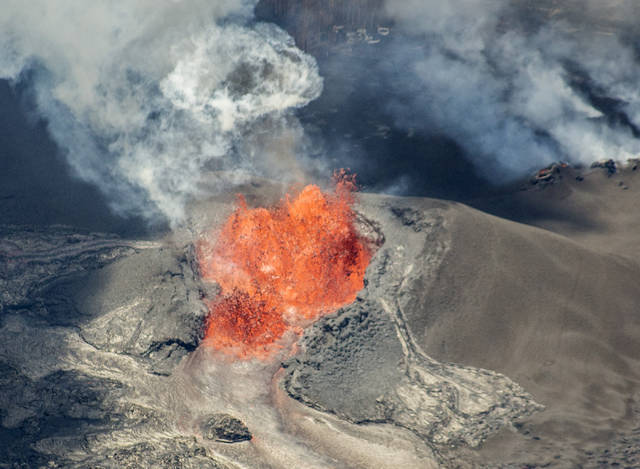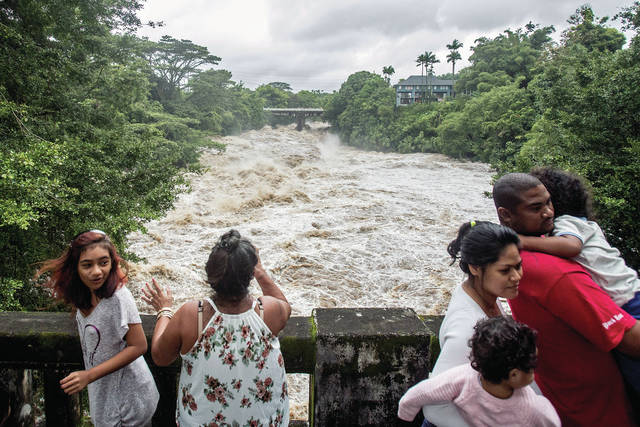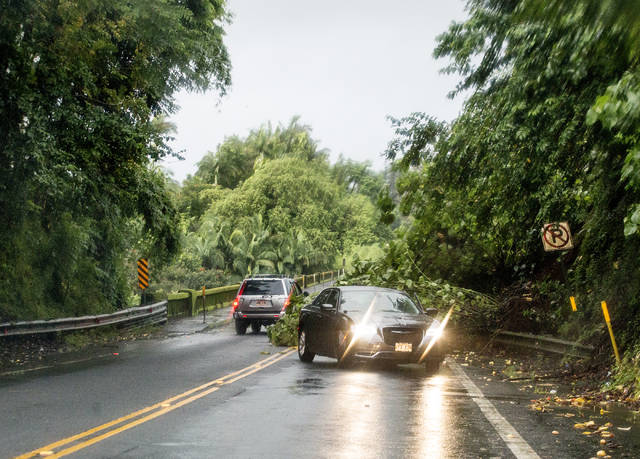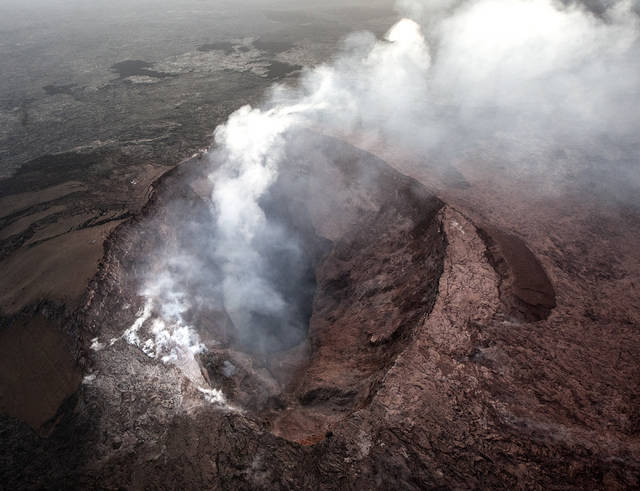Aloha, 2018! The Tribune-Herald’s top stories of the year




Earth has made another revolution around the sun and, as we get set to ring in 2019, it’s time to look back at the year that was 2018.
Earth has made another revolution around the sun and, as we get set to ring in 2019, it’s time to look back at the year that was 2018.
In addition to White House firings and resignations too numerous to detail, 2018 is marked with a mind-boggling number of disasters locally, nationally and globally.
ADVERTISING
Hurricane Florence blew ashore from the Atlantic in September, causing 53 confirmed deaths, mostly in the Carolinas. In October, Hurricane Michael slammed into the Florida panhandle, leveling cities and leaving at least 36 dead. Typhoon Manghut brought widespread damage to Guam, the Philippines and South China, and was responsible for at least 134 fatalities, 127 of them in the Philippines. Typhoon Yutu wreaked havoc in both the Philippines and the Northern Marianas Islands of Saipan and Tinian, killing 27.
Wildfires in California killed at least 88 people — and that total may still rise, as hundreds are still missing and unaccounted for.
And a tsunami in Indonesia just before Christmas killed more than 430 people.
Notable deaths this year include 41st President George H.W. Bush and his first lady, Barbara Bush, U.S. senator and former presidential candidate John McCain, former Hawaii U.S. Sen. Daniel Akaka, former United Nations Secretary-General Kofi Annan, pioneering astronaut John Young, the “Queen of Soul” Aretha Franklin, physicist and author Stephen Hawking, chef-turned-author and TV host Anthony Bourdain, handbag designer Kate Spade, playwright Neil Simon, author Philip Roth, Saudi journalist Jamal Khashoggi, actress and director Penny Marshall, evangelist Billy Graham, comic book creator Stan Lee, jazz trumpeter Roy Hargrove and movie star Burt Reynolds.
Some prominent Big Islanders passed in 2018, as well. They include: pacemaker developer and Medtronic founder Earl Bakken; self-made car dealer and entrepreneur David De Luz; former University of Hawaii at Hilo chancellor Edward Kormondy; murdered police officer Bronson Kaliloa; second-generation Hawaiian music legend and UH-Hilo slack-key guitar teacher Cyril Pahinui; rapper, activist and radio personality Donald “Ke‘ala” Kawa‘auhau, also known as “King Don 1” of Sudden Rush; Kahua Ranch patriarch and community benefactor Herbert “Monty” Richards; rancher and community activist Harold “Freddy” Rice, whose Rice vs. Cayetano lawsuit opened up Office of Hawaiian Affairs elections to the entire Hawaii electorate; Kona businesswoman and community volunteer Maralyn “Marni” Herkes; activist Lanric Hyland; Brian Hughes, a Hilo-born federal firefighter who died battling the Ferguson fire in California; and former child actress and singer Donna Butterworth, who co-starred with Elvis Presley in “Paradise, Hawaiian Style.”
And now, we bring you the Top 10 local stories of 2018 as selected by the editorial staff of the Hawaii Tribune-Herald:
1. Kilauea erupts
On April 30, Pu‘u O‘o’s crater floor collapsed after steady inflation of its cone since March, causing hundreds of small tremors along Kilauea volcano’s East Rift Zone and sending underground magma downrift.
Then on May 3, a 5.0-magnitude temblor prompted Pu‘u O‘o’s cone to emit a plume of red ash that was seen for miles. That afternoon, a volcanic eruption forced the evacuation of Leilani Estates and Lanipuna Gardens in lower Puna after lava burst through cracks in the middle of a residential street in Leilani.
On May 4, a 6.9-magnitude earthquake struck on the south flank of Kilauea, the largest quake in Hawaii in 43 years. The massive temblor drove home the enormity of what was happening beneath the earth’s surface.
The lower East Rift Zone eruption, the largest in more than two centuries, would change not only the landscape, but also the lives of thousands of Big Island residents. The earth’s crust was breached by two dozen fissures, with at least one, fissure 8, sending rivers of molten rock downhill for months.
Simultaneously, collapse-explosion events occurred regularly inside Halema‘uma‘u crater at the summit of Kilauea volcano inside Hawaii Volcanoes National Park, dramatically increasing the size of the crater. The park was closed for 134 days and the Jaggar Museum, perched on the crater’s overlook, was deemed unsafe and its exhibits were removed.
The eruption also necessitated moving of Hawaiian Volcano Observatory to the University of Hawaii at Hilo campus.
Evacuation shelters were opened, housing more than 400 displaced individuals at their peak, including residents of Kapoho Vacationland subdivision, which had no homes remaining, Kapoho Beach Lots, where all but a few homes were destroyed by lava, and surrounding areas. In all, more than 700 homes were consumed by lava between May and August.
Numerous Pahoa businesses closed, and many continue to suffer economically from the lava crisis.
Lava crossed Highways 132 and 137 plus Pohoiki Road in lower Puna. Underground magma movement caused cracks in Highway 130 that were later covered by steel plates, and cracks and sinkholes developed on Highway 11 in the Volcano area.
While much of lower Puna was inundated by lava, the nerves of Volcano village residents and cash registers of its businesses were adversely affected for months by Halema‘uma‘u’s seismic activity and the national park’s closure.
Other casualties of the lava include Wai‘opae Tide Pools, Champagne Pond, Ahalanui Beach Park and Kua O Ka La Public Charter School, all in lower Puna. Lava entered the parking lot at Isaac Hale Beach Park in Pohoiki, but the county park itself and the state-owned Pohoiki boat ramp, which is accessed through the park, were spared.
Isaac Hale Beach Park was reopened in early December after the county bulldozed through lava on Highway 137 and reopened the road.
Dozens of sightseers, informally dubbed “lava loiterers,” were cited by authorities for trespassing to get a closer look at lava in areas deemed restricted to the public. There also were reports of burglars and squatters taking advantage of evacuated homes.
The lava’s destruction ended in early August, and in early September, no molten lava was visible within the cone of fissure 8.
2. The rain from Lane
Although no hurricanes made landfall in Hawaii, there were a number of close calls, including from Hurricanes Hector, Norman and Olivia. But one storm in particular, Hurricane Lane, was especially problematic for East Hawaii.
The former tropical cyclone had already passed the Big Island and was being torn to remnants by wind shear when the storm’s outer rain bands dropped a deluge of historic proportions on East Hawaii in late August.
The National Weather Service described the downpour — which damaged numerous homes and businesses, destroyed two homes in Hawaiian Acres subdivision, and caused evacuations in Reed’s Island in Hilo and Keaau Ag Lots — as the “third highest storm total rainfall from a tropical cyclone in the United States since 1950.”
Mountain View received 51.53 inches of rain between noon Aug. 22 and 4 a.m. Aug. 26.
Damage to county facilities totaled about $20 million, and an estimated 152 homes were damaged, with 59 sustaining major damage from Lane, Managing Director Wil Okabe said.
3. This is not a drill
With those words, all capitalized, flashing across cellphones statewide at 8:07 a.m. on Jan. 13, a Saturday, islanders were warned of an impending nuclear catastrophe: North Korea had fired intercontinental ballistic missiles at Hawaii.
Although state officials knew almost immediately the chilling text message from Hawaii Emergency Management Agency — which was re-transmitted via TV and radio — was a false alert, it took 38 minutes for the state to issue another cellphone alert cancelling the false alarm. It took 13 minutes for the state to announce it was a false alarm on social media platforms, with Gov. David Ige blaming the lapse on having forgotten his Twitter password.
The employee who sent out the false alert, a man in his 50s, thought it was a real missile emergency, although others on the same watch heard the word “exercise” several times and knew the alert shouldn’t have been sent to the public, authorities said. The employee was, at first, reassigned to another position, but was later fired, ostensibly because of public pressure. He’s filed a wrongful-termination lawsuit against the state.
Then-HI-EMA director Vern Miyagi resigned after the fiasco and was replaced by retired Navy Capt. Tom Travis, a former Big Island resident.
4. Pocketbook pinch
Big Islanders should be prepared to pay more for just about everything in 2019.
Five county taxes and fees have been recently hiked or are in the process of being raised. That includes property taxes, which were raised in 2017 on all classes of properties with the exception of homeowner and affordable rental.
The county has increased its share of gasoline taxes each of the past four years, with the pain at the pump going up from 19 to 23 cents per gallon in 2019, and annual vehicle safety check stickers up $5.81 each. Water bills are up an average of 8 percent for residential users, and the county plans to increase sewer fees 44 percent in 2019.
In addition, the county will assess a quarter-cent surcharge on state general excise tax starting Jan. 1, meaning you’ll pay an extra 4.25 cents per dollar for retail goods and services.
Those retail goods are likely going up, as well. Matson, the largest shipper of goods to the islands, increased its fuel surcharge from 27.3 percent in 2017 to 38.5 percent in 2018, an increase of 41 percent.
Tipping fees for commercial rubbish haulers went up a whopping 27 percent in 2018 and will increase a modest 2 percent in 2019.
And electricity went up about 7.4 percent in 2018, with Hawaii Electric Light Co. requesting an additional 3.4 percent rate hike.
5. High court paves way for TMT
On Oct. 30, the Hawaii Supreme Court voted 4-1 in favor of granting a Conservation District Use Permit to allow the next-generation Thirty Meter Telescope to be built on Maunakea.
A month later, the high court voted down two motions to reconsider that decision.
Scott Ishikawa, a spokesman for TMT International Observatory, said the organization is working to fulfill pre-construction requirements set by the permit issued by the Board of Land and Natural Resources.
He said a resumption in construction would take “at least several months.”
Some opponents of the project have said they plan to try to block construction. Protesters, who call themselves “protectors,” repeatedly blocked construction vehicles in 2015 before the high court overturned the original permit because of due process issues.
BLNR issued another permit in 2017 after a lengthy contested case hearing, which led to another appeal to the Supreme Court.
6. Cop killing spurs manhunt
On the evening of July 17, Officer Bronson Kaliloa, a 10-year veteran of the Hawaii Police Department, was shot and killed by the side of Highway 11 near Kukui Camp Road in Mountain View.
The 46-year-old Kaliloa, a married father of three and Puna Officer of the Year for 2014, became the fifth Big Island police officer killed in the line of duty and the first to die of gunfire.
Kaliloa’s death spurred an islandwide manhunt for Justin Joshua Waiki, a felon wanted on a warrant revoking his bail. Waiki was shot and killed July 20 by officers during a shootout on South Point Road in Ka‘u. Sgt. Bryan Tina of the Special Response Team, the department’s SWAT unit, suffered nonfatal gunshot wounds in the shootout.
Police Chief Paul Ferreira called Kaliloa’s shooting “the worst day of my 36-year-career,” and Kaliloa’s funeral on Aug. 4 drew more than 1,000 people, including police and other first-responders from across Hawaii and beyond.
7. Hilo redevelopment bill becomes law
Gov. David Ige came to Hilo in early July to sign Senate Bill 3058, a measure that establishes a “Hilo community economic district” around the Kanoelehua Industrial Area.
The law creates a sprawling redevelopment district for Hilo under a 10-year pilot program, which encompasses all state lands in the industrial area as far south as Makaala Street, Banyan Drive and the Waiakea Peninsula, Wailoa River State Recreation Area, the Bayfront ball fields and along Kalanianaole Avenue.
The law allows tenants within the district to extend their leases for up to 40 years if they make substantial improvements, subject to Land Board approval. Many of the leases were established after the 1960 tsunami and are facing expiration. Members of the business community say those whose leases are expiring have little incentive to invest in the property, leading to dilapidation in areas such as the KIA, where the state leases almost 80 parcels.
Hawaii Island Chamber of Commerce President Gordon Takaki said the bill is “probably the biggest thing to happen to the KIA” since it was established in 1960.
Jason Fujimoto, president and chief operating officer for HPM Building Supply, said HPM is preparing to submit its lease extension application to the state Department of Land and Natural Resources in early 2019.
8. Fines for farmers market
On March 16, the county sent a letter to Hilo Farmers Market owner Keith De La Cruz, informing him he’d reached the deadline to complete a permanent structure for the iconic market at the corner of Kamehameha Avenue and Mamo Street. The letter also stated the market was in violation of the county’s zoning, building and fire codes, and he would be fined $1,000 a day for each of four parcels the market occupied for each day violations continued to occur.
The market closed down for a day a week later, and the tarps and tents covering the market were replaced with individual pop-up tents De La Cruz instructed owners to buy and which the county also deemed as unacceptable. County inspectors continued citing violations at the market and, as of October, accrued fines totaled more than $200,000.
Mayor Harry Kim said last week De La Cruz met a Dec. 14 deadline for submitting new plans for a permanent market structure to the county.
9. Council passes vacation rental bill
The County Council in late November passed on a 6-1 vote a bill regulating short-term vacation rentals on Hawaii Island.
The final measure, passed in November, was the culmination of seven drafts and extensive community input over a two-year period.
It’s now up to the Planning Department to formulate the rules which, when drafted, will face a public hearing. Those rules are expected to be finalized by April 1.
Hawaii County becomes the last in the state to regulate short-term rentals in residential neighborhood.
“This must be controlled because of the disturbance of a lifestyle,” Mayor Harry Kim said in favor of the measure. “Vacation rental is a business. It’s not a good or bad business, it’s just a business. … This is good where it is controlled.”
10. A brown Christmas
Big Island Dairy, which announced its intention to cease operations in 2019, discharged manure-laden wastewater into Ookala gulches over the holidays.
According to the Department of Health, owners of the beleaguered dairy reported Christmas morning that about 800,000 gallons of wastewater was expected to be discharged during pumping activities throughout the day.
“(There’s) nothing like having the dairy say ‘Merry Christmas’ to the community by releasing close to a million gallons of effluent into the community,” Ookala resident Charlene Nishida said.
A discharge in May released nearly 2.3 million gallons of rain and wastewater during a period of three days, and in August, heavy rain from Hurricane Lane caused a wastewater pond at the dairy to overflow, sending untreated effluent into a nearby gulch.
The DOH issued the dairy fines of $91,000 on Dec. 4 for three separate spills between April and May.
That comes more than a year after DOH fined the dairy $25,000 in May 2017 for unlawful discharge of wastewater.
A lawsuit alleging the dairy violated the federal Clean Water Act was filed in 2017 in U.S. District Court in Honolulu.
Honorable mentions
As usual, there are a number of important stories worthy of mention which did not make the Top 10 list. They include: the acquisition of the Great Crack Property in Ka‘u in September by the National Park Service; four individuals killed and another injured in police-involved shootings; former Puna Councilwoman Jen Ruggles refusing to vote her final two months in office, based on her belief the county and council are illegal entities and her votes might constitute war crimes; work continues on the Hu Honua power plant in progress, despite legal challenges and a $25,000 fine for discharging industrial wastewater into the ocean on Nov. 9; and the Keauhou Ranch fire in August blackened more than 3,700 acres on the slopes of Mauna Loa, mostly within Hawaii Volcanoes National Park.
Hawaii Tribune-Herald reporters Tom Callis, Michael Brestovansky and Stephanie Salmons and West Hawaii Today reporter Nancy Cook Lauer contributed to this story.
Email John Burnett at jburnett@hawaiitribune-herald.com.


